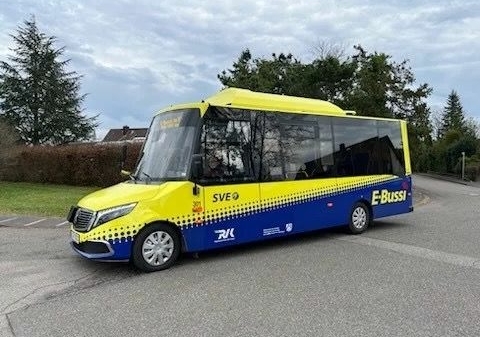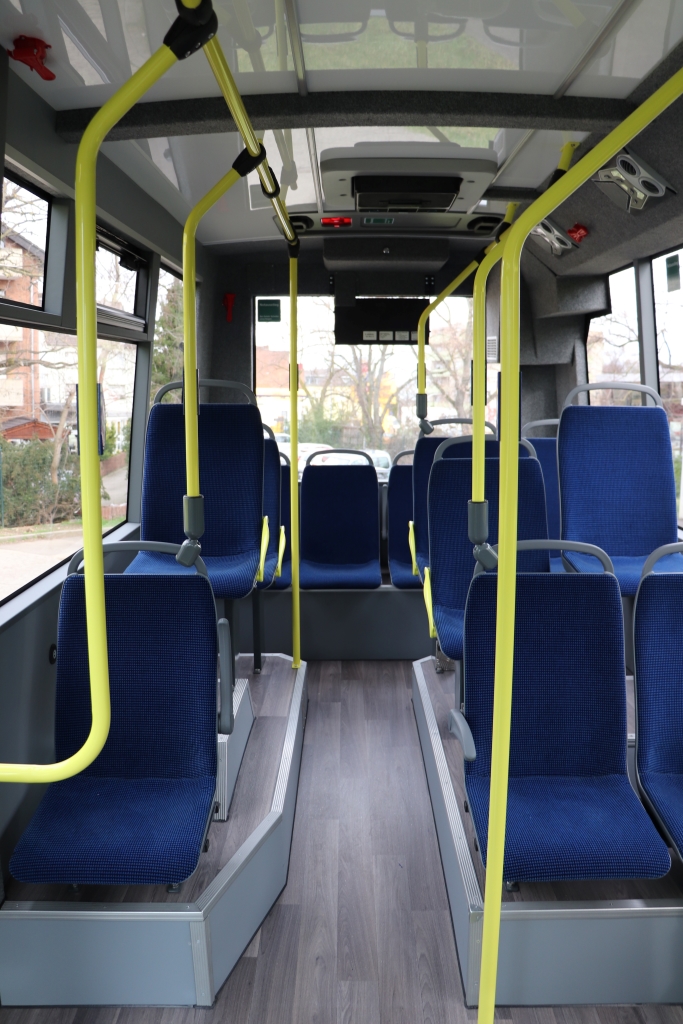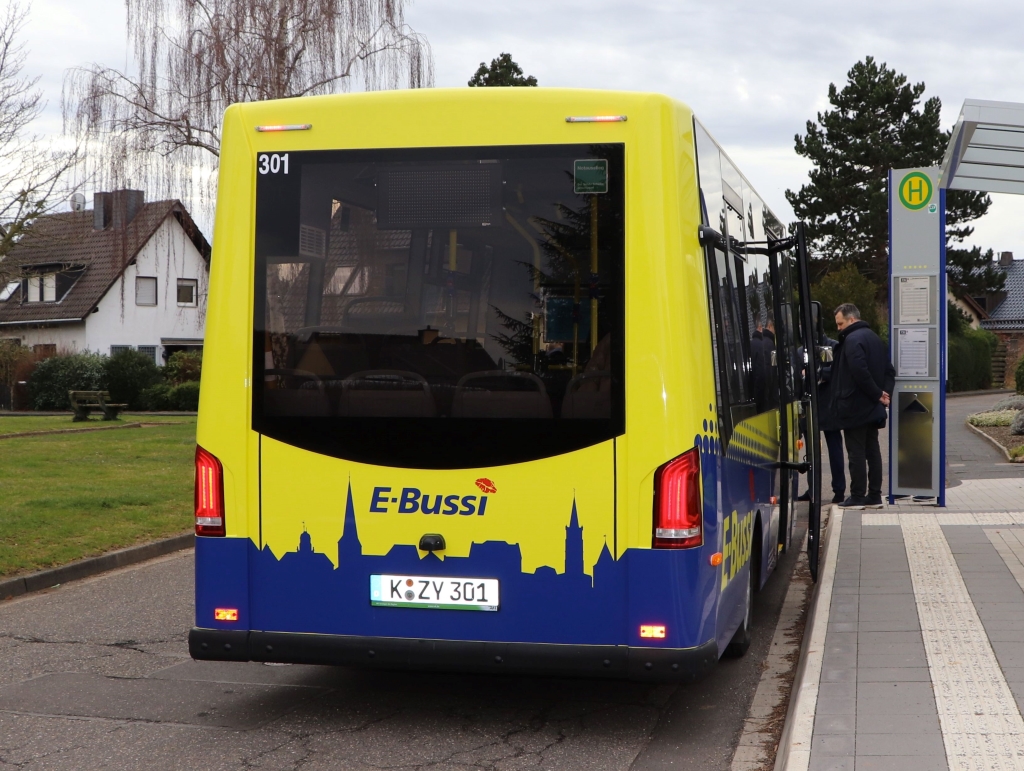
The district town of Euskirchen is located in the south-west of North Rhine-Westphalia in the triangle formed by the cities of Cologne, Bonn and Aachen. As at 31 December 2022, it had 59,772 inhabitants. It reached its current size in 1969 when numerous neighbouring villages from the district of Euskirchen were incorporated into the town.
A private company from Euskirchen operated a city bus route in the old town centre. The new neighbourhoods that were incorporated were initially only connected by intercity lines from Euskirchen.
This changed on 3 June 1996, when Stadtverkehr Euskirchen GmbH (SVE), founded in November 1995, opened its two lines 871 (Marienhospital – railway station – Memelstraße) and 872 (Pappelallee – railway station – Erftstadion – Nordstadt) in the town centre. Both lines ran every 30 minutes. Whenever the trains from Bonn, Cologne, Münstereifel and Trier met at the station (mainly on the hour and half hour), the buses also came to the station. This meant that it was not only possible to change between bus and train, but also that every city bus had a connection to the others.
Euskirchen’s city transport always belonged to the Verkehrsverbund Rhein-Sieg / Rhine-Sieg transport association (VRS). In order to finance the costs of the city bus, the city brought its car park management into the city transport company. The idea was to use the income from the car parks and car park management to offset the costs of the city bus.
The SVE has never had its own buses; it acts as the public transport authority that orders the services in the municipal route network. After the private operator Laschke from Euskirchen had operated the city bus service until 2 June 1996 and the concession was still valid for some time, the operation of the two routes was initially awarded to Laschke, which voluntarily waived its concession rights. Laschke procured six Neoplan N 4011 low-floor midibuses for the two lines, four of which were used for the two lines, the fifth was a reserve vehicle, and the sixth could step in when and where necessary.
By the autumn of 1997, Euskirchen’s city bus network had already grown considerably, as many of the towns incorporated in 1969 were now connected to the city bus network. The following lines were added:
873: Railway station – Roitzheim – Stotzheim – Kirchheim – Steinbachtalsprerre
874: railway station – Kuchenheim – Palmersheim – Flamersheim – Kirchheim
and 875: railway station – Kleinbüllesheim – Großbüllesheim – Wüschheim – Dom-Esch.
The large regional transport company in the region, RVK (Regionalverkehr Köln), applied to operate these lines. As a result of the tender, it was also awarded the contract. It also put Neoplan N 4011s into service for Euskirchen’s city lines, also in yellow and dark blue, the colours of Euskirchen’s city transport company.
In the meantime, the city council had decided that the buses should run every 15 minutes instead of every 30 minutes due to their success. Laschke stepped out of the city bus service, and since then RVK has operated the entire Euskirchen city transport service on its own. Laschke operates on RVK routes in the greater Bonn / Euskirchen area on behalf of RVK.
In 2008, the “small” Neoplan midibuses were due to be taken out of service. They were only partially replaced by midibuses (Mercedes-Benz Citaro K), but for the most part by full-size 12-metre buses (Mercedes-Benz Citaro). And in 2021, with the changeover to the next generation of vehicles, only “full-grown” 12-metre Citaro buses were introduced. However, they no longer run on diesel, but on bio-methane. Although this is not emission-free, it is much less polluting.

Seven electric minibuses
Now, however, Euskirchen’s city buses are making a huge leap forward. On 15 February, seven electric minibuses from the Austrian/Slovenian manufacturer K-Bus (Kutsenits) of the type “E-Solar City XL” were presented at the RVK depot in the city. They bear the RVK vehicle numbers 301 to 307 and are registered with the licence plates “K-ZY 301” to “K-ZY 307”. On the one hand, they are intended for route 877 (railway station – Südstadt – Kreuzweingarten). The final stop in the Kreuzweingarten district is on Münsterbergstraße. You can get there with a full-size bus, but due to the road expansion, a small bus is more appropriate, and it is also sufficient for the passenger volume.
Line 877 runs at hourly intervals, one carriage is sufficient to make the round trip from the station to Kreuzweingarten – station in this hour. Nevertheless, Kreuzweingarten – apart from the Münsterberg area – is not limited to the hourly interval, as the district is also served by line 801 (Euskirchen – Münstereifel), which runs at 30-minute intervals.
One of the new buses is therefore needed for line 877, while a second is a reserve bus. And the other five? They are to be used as reinforcement buses, especially for school transport, and replace large buses on the other routes during off-peak times.
Euskirchen’s new minibuses are also painted in the yellow/dark blue colour of the Euskirchen city bus. And they have had a good idea: the silhouette of the town of Euskirchen can be seen under the window pane at the rear.


The small electric buses have been given the name “E-Bussi”. It is also written on the sides of the rear of the buses. The “i-dot” is in the shape of a kissing mouth,
It is interesting to note that RVK, which relies heavily on hydrogen for alternative drive systems – hydrogen bus number 100, a vehicle from the Northern Irish manufacturer Wrightbus, will soon go into service – has now put its battery buses three to nine into service with the small electric buses for Euskirchen. Two “Solaris Urbino 12 electric” buses – RVK numbers 100 and 300 – preceded them in September.
The technology of the small electric buses
Let’s take a closer look at the new “E-Solar City XL”. The buses are 7,595 mm long, 2,410 mm wide and 3,100 mm high. RVK and Stadtverkehr Euskirchen GmbH point out that thanks to their small dimensions, the trolleys are particularly suitable for travelling on narrow and steep roads. They are also very quiet and, above all, emission-free thanks to their electric drive.
There are 15 seats and 10 standing places, and a wheelchair can be taken along, which is accessed via a ramp that is folded out by hand. This may also be an electric wheelchair – they take up more space and are heavier.
Empty, a “E-Bussi” weighs 4,215 kg, the total weight is 6,000 kg. The electric motors is a Mercedes-Benz which allows a Vmax of 80 km/h. Their range is 200 kilometres.
Behind the front axle, the buses have a double-width external swing door, and a low entry height provides easy access to the low-floor buses. Double monitors provide passengers with information. The buses are equipped with WLAN and there are double USB plugs in each row of seats.
Safety is ensured by a blind spot assistant that recognises people and obstacles in the area that the driver cannot see. The new minibuses also have a fire alarm system. “Auto Hold” prevents the vehicles from rolling away unintentionally, and the anti-lock braking system (ABS) and anti-skid control (ASR) are (almost) a matter of course in buses today.
The charging infrastructure at the Euskirchen depot
On 17 October last year, RVK began to set up the charging station at its Euskirchen depot in collaboration with GP Joule Connect GmbH. Five charging points were installed, each with two charging points, so that ten vehicles can be charged at the same time. The recharging time is 1.5 to 2 hours. The vehicles are connected to the charging points via CCS combo plugs.
The system is of course suitable for minibuses, but “full-size” buses can also recharge here, and cars that RVK has in its fleet as company vehicles can also refuel here.
About the costs
A total of 2.6 million euros has been invested in the deployment of the electric minibuses in Euskirchen. The state of North Rhine-Westphalia and the public transport authority “go.Rheinland” subsidised 60% of the additional costs for the purchase of the electric minibuses and 90% of the costs for the construction of the recharging system.



